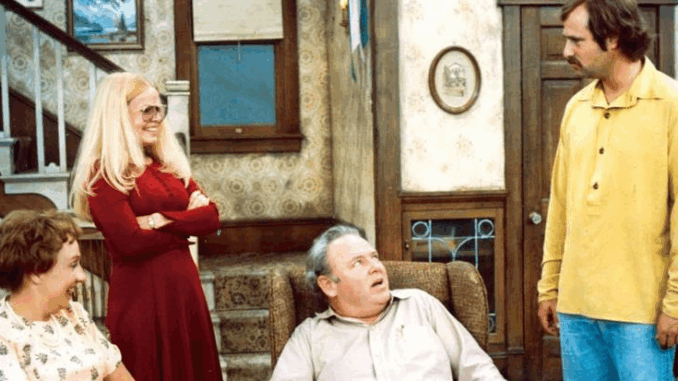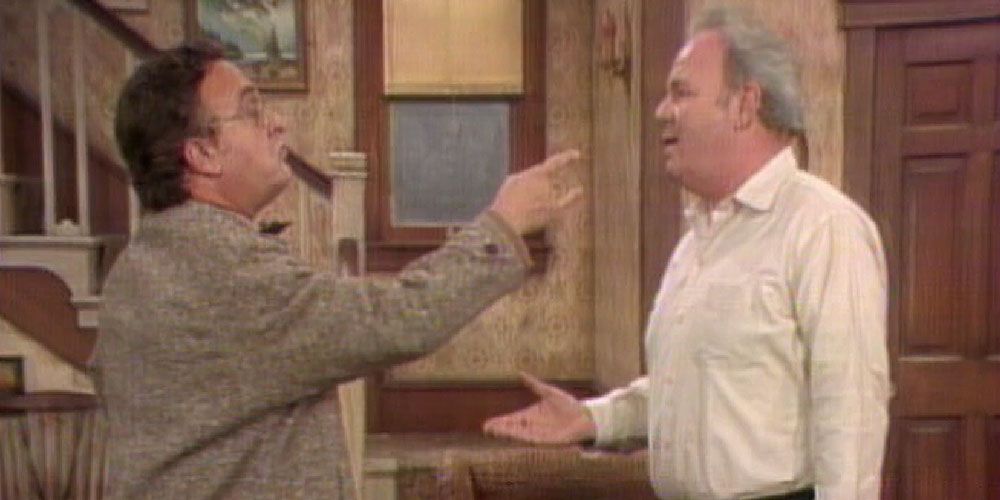
The 1970s classic sitcom All in the Family is widely regarded as one of the most groundbreaking and influential shows in television history. Premiering in 1971, the series captured the everyday life of the outspoken and often controversial Archie Bunker (played by Carroll O’Connor) and his family as they navigated social and political issues of the time. Archie’s sharp tongue and strong opinions—many of which would be considered offensive today—made him one of TV’s most polarizing yet unforgettable characters.
Across nine seasons, viewers became deeply familiar with Archie’s devoted wife Edith (Jean Stapleton) and their daughter Gloria (Sally Struthers), as well as Gloria’s liberal husband Michael “Meathead” Stivic (Rob Reiner). The family dynamic struck a chord with millions of Americans, earning the show critical acclaim and an enduring fanbase. Yet, even devoted viewers might be surprised to learn the numerous behind-the-scenes details and fascinating production secrets that helped shape the iconic sitcom.
Here are 10 incredible facts about All in the Family that only the most dedicated fans are likely to know.
The Show Led to an Astonishing Seven Spin-Offs
It’s not unusual for a popular TV series to inspire one spin-off, but All in the Family defied expectations by spawning an incredible seven spin-offs. This impressive legacy includes The Jeffersons, Maude, Good Times, Archie Bunker’s Place, Gloria, Checking In, and 702 Hauser Street.
While most spin-offs struggle to capture the success of their predecessor, many of these series became classics in their own right—most notably The Jeffersons, which ran for 11 seasons. This unique achievement solidified All in the Family’s place in television history as a franchise-defining series.
Edith’s Death Took Place in a Spin-Off, Not the Original Show
Many fans vividly remember Archie grieving the death of his beloved wife Edith, clutching one of her pink slippers in a heartbreaking scene. However, what some may not realize is that this moment didn’t happen in All in the Family.
Edith’s death actually occurred in the pilot episode of the spin-off series Archie Bunker’s Place, which aired after the original sitcom had ended. Because the emotional scene left such a lasting impression, it’s easy to see why viewers often misremember it as part of the flagship show.
Harrison Ford Was Almost Cast as Michael

Before Rob Reiner won the role of Michael Stivic, producers approached none other than Harrison Ford to play Gloria’s husband. Ford ultimately turned the role down, reportedly uninterested in committing to a long-term TV series.
While it’s impossible to imagine anyone else but Reiner as “Meathead,” it’s fascinating to think how Ford’s career trajectory might have been different if he had accepted the role. Of course, Ford went on to achieve superstardom with films like Star Wars and Indiana Jones, so the decision certainly worked out for him.
Fans Were Confused by the Theme Song Lyrics
The iconic opening theme, “Those Were the Days,” became one of television’s most recognizable songs, but it also puzzled many viewers. Fans were so confused by the lyric “Gee, our old LaSalle ran great” that they wrote letters and even phoned the network asking for clarification.
To address the issue, the song was re-recorded for season three with clearer enunciation so audiences could finally understand the nostalgic line about the classic LaSalle automobile.
Mickey Rooney Turned Down the Role of Archie
Before Carroll O’Connor became synonymous with Archie Bunker, legendary actor Mickey Rooney was offered the part. Rooney declined, warning producer Norman Lear that the show’s controversial subject matter would “get him killed.”
The role ultimately went to O’Connor, and it’s now impossible to picture anyone else delivering Archie’s biting humor and distinctive worldview. Rooney’s hesitation, however, underscores just how bold All in the Family was for its time.
Sally Struthers Missed Two Episodes Due to a Legal Dispute
Sally Struthers, who played Gloria, found herself at the center of a legal battle with Tandem Productions in 1975. Struthers had been offered a leading role in the film The Day of the Locust, but her contract stated that she couldn’t appear in any other projects outside of All in the Family.
As a result of the dispute, Struthers was absent from two episodes of the series. The controversy highlighted the intense contractual restrictions actors often faced while starring in hit TV shows.
Rob Reiner Wore a Hairpiece in Season One
Rob Reiner may have been just 24 years old when he joined the cast, but he was already dealing with hair loss. During the first season, Reiner wore a hairpiece to maintain Michael’s youthful appearance.
The fact that he wore a wig on camera is subtle enough that most viewers never noticed—another little-known detail that only die-hard fans might be aware of.

Archie’s Future Was Threatened by a Contract Dispute
Behind-the-scenes negotiations were sometimes as dramatic as the on-screen storylines. In 1974, Carroll O’Connor clashed with Norman Lear over salary and contract terms. At one point, Lear even threatened to kill off Archie Bunker’s character if the dispute wasn’t resolved.
During the tense standoff, five episodes aired without Archie, leaving fans unsettled about his potential fate. Fortunately, the matter was resolved, and O’Connor continued playing the iconic role for the remainder of the series.
The Series Was Based on a British Sitcom
Although All in the Family became an American cultural touchstone, it wasn’t an entirely original concept. The series was actually adapted from the British sitcom Till Death Do Us Part, which aired on BBC1.
The British version was even darker in tone than Lear’s adaptation, but the core concept—a working-class father with conservative views clashing with his liberal son-in-law—remained intact.
It Was Originally Called Justice for All
Before Archie Bunker became a household name, the character’s last name was originally Justice, and the show was set to be titled Justice for All. While the name wasn’t terrible, it certainly lacked the warmth and family-centric branding of All in the Family.
Thankfully, the title was changed, and the rest is history. It’s now hard to imagine the iconic sitcom being called anything else.
All in the Family wasn’t just a sitcom; it was a cultural phenomenon that reshaped American television. The show fearlessly tackled topics like race, class, politics, and gender in ways that were rarely seen on network TV at the time. Its enduring popularity, multiple spin-offs, and unforgettable characters have cemented its place as one of the greatest shows ever made.
For longtime fans and new viewers alike, revisiting these behind-the-scenes facts offers a deeper appreciation of the artistry, risk-taking, and brilliant performances that made All in the Family so special.
